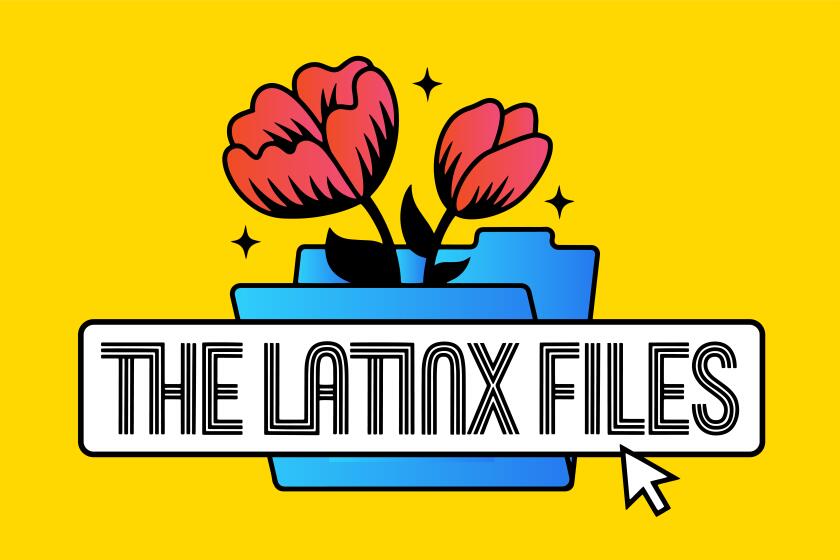Why we chose the name Latinx Files for our new newsletter

It’s not lost on me that choosing to have “Latinx” in the name of The Times’ new newsletter might rub some people the wrong way. So why call it the Latinx Files?
For me, the use of the term is personal and comes from talking with members of our community who have felt marginalized by other terms used to identify us. It came from talking with friends and colleagues who identify as such, from talking to those who want to make others feel like they belong.
One of these conversations helped crystallize for me why the terms we use are critical to acceptance and understanding.
In June 2019, I interviewed members of Pasión 1927, a Los Angeles-based fan group of Mexico’s national soccer team, on why they had made it their policy to ban a popular homophobic chant associated with the team. José Salsedo, one of the group’s leaders, admitted that he previously used the chant and would defend it by claiming that it wasn’t intended to be homophobic.
The Latinx experience chronicled
Get the Latinx Files newsletter for stories that capture the multitudes within our communities.
You may occasionally receive promotional content from the Los Angeles Times.
“The day I had a conversation with someone from the LGBT community, and they explained to me how [the chant] made them feel, how they feel offended, that’s when I changed my point of view,” he told me.
“That’s when I told myself I was ignorant and I needed to educate myself.”
Salsedo realized that, by using the chant, he was inadvertently telling LGBTQ soccer fans that they weren’t welcome, which is the opposite of Pasión 1927’s mission of uniting El Tri fans across Southern California.
That same reasoning is behind why I chose to use “Latinx.” When I say that I want this newsletter to be a space for everyone, I mean everyone. That includes people who don’t identify as male or female, who don’t see gender as binary.
It’s not a coincidence that the word “Latinx” gained popularity after the 2016 Pulse mass shooting, where 49 people were killed at the LGBTQ nightclub. Many of those killed were Latinx — the shooter opened fire on Pulse’s “Latin Night.”
In the inaugural Latinx Files newsletter, we discuss the choice of the name and take a closer look at the Mexican American vote in Texas and the Cuban American vote in Florida.
I’m not saying that you’re homophobic if you don’t use the word “Latinx.”
I’m not saying that it’s what you should call yourself or that it should replace “Hispanic” or “Latina” or, in my case, “Tejano.”
I don’t even care if you use it.
I have heard and read many of the criticisms of the term, and I understand them. I don’t agree with them, but I get the points that opponents of the term make. (If you would like to read op-eds against the term, here is one of the early viral pieces against “Latinx,” and here’s one published in the Los Angeles Times.)
What I am saying is that there are indeed members of our community for whom the “x” helps them feel like they belong.
None of the terms used to describe our community exclude me, but some of them do exclude others. “Latinx,” to me, is the one term that includes everyone.
I also realize that “Latinx” is not as widely used within our community when compared with terms like “Hispanic” and “Latino/Latina,” according to a recently published report by Pew Hispanic Trends. (But you probably already knew that, or at least were able to guess as much given that I’m writing this in the first place.)
But here’s the thing: Language is ever-evolving. This is true for how we as a community have described ourselves and how this news organization’s style guide has changed over time.
Take “Hispanic.” According to that Pew study, 61% of those surveyed said they preferred that word to describe the larger community — only 29% went with “Latino/Latina.” Given those numbers, you would think the term has been around forever. It hasn’t. Its rise in popularity dates to 1975, and it didn’t always enjoy the same broad acceptance it does today. In 1983, only 14% of Californians with Latin American ancestry polled by The Times said that it was their preferred term for self-identification.
Despite the seeming current popularity of “Hispanic,” the Los Angeles Times style guide gives preference to “Latino,” thanks in large part to the late, great Frank del Olmo, the first Latino (that’s what he preferred) to be listed on the newspaper’s masthead.
And as far as I know, that will remain The Times’ policy — except in this space.
Which brings me to how I’m planning on using “Latinx.” You will only see it in the newsletter when it’s me writing. It won’t be in quotes unless the person who provided the statement actually used it, nor will I use it to replace “Hispanic” or “Latino” in proper nouns — the Congressional Hispanic Caucus will not become the Congressional Latinx Caucus, nor will “Latino USA” become “Latinx USA.”
To me, the term “Latinx” is also a nod to what’s to come, of where we’re going.
In 2016, nearly six in 10 Latinxs were millennials or younger, and nearly a third were under the age of 18. Our community is younger than the white, Black and Asian American communities, and although a sizable portion of us eschew the term, it’s the youngest among us who are most likely to use it.
“Latinx is futuristic because it subverts the Spanish language by erasing the gender binary,” G. Cristina Mora, who teaches sociology at UC Berkeley, told the New Yorker in September.
Mora is the author of “Making Hispanics: How Activists, Bureaucrats, and Media Constructed a New American,” which is a deep exploration into how people from 20 different countries, of varied races and backgrounds, came to be seen as one community.
“As far as I know, we are the only ethno-racial group where this kind of discussion over labeling is going on.”
This newsletter is more than just a name. The goal of the Latinx Files is to get our stories on the record, to chronicle a future that truly is Latinx while still holding on to where we came from.
The Latinx experience chronicled
Get the Latinx Files newsletter for stories that capture the multitudes within our communities.
You may occasionally receive promotional content from the Los Angeles Times.





